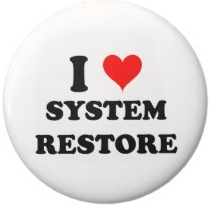Microsoft System Restore: Difference between revisions
Created page with "The Microsoft System Restore tool will return your computer to a previous state. System Restore takes "snapshots" of critical system files and some program files and registry set..." |
No edit summary |
||
| Line 1: | Line 1: | ||
The Microsoft System Restore tool will return your computer to a previous state. System Restore takes "snapshots" of critical system files and some program files and registry settings and stores this information as restore points. If your computer is not functioning correctly, you can use these restore points to return Windows XP to a previous state when your computer was functioning correctly. It can also change scripts, batch files, and other kinds of executable files on your computer. | [[File:systemrestorelove.jpg|left]] The Microsoft System Restore tool will return your computer to a previous state. System Restore takes "snapshots" of critical system files and some program files and registry settings and stores this information as restore points. If your computer is not functioning correctly, you can use these restore points to return Windows XP to a previous state when your computer was functioning correctly. It can also change scripts, batch files, and other kinds of executable files on your computer. | ||
System Restore does not affect personal files, such as e-mail, documents, or photos. You can only restore files that you have deleted if you have made backups of those files. | System Restore does not affect personal files, such as e-mail, documents, or photos. You can only restore files that you have deleted if you have made backups of those files. | ||
Revision as of 15:08, 17 December 2011

The Microsoft System Restore tool will return your computer to a previous state. System Restore takes "snapshots" of critical system files and some program files and registry settings and stores this information as restore points. If your computer is not functioning correctly, you can use these restore points to return Windows XP to a previous state when your computer was functioning correctly. It can also change scripts, batch files, and other kinds of executable files on your computer.
System Restore does not affect personal files, such as e-mail, documents, or photos. You can only restore files that you have deleted if you have made backups of those files.
To perform the System Restore, you must be logged on to Windows as an administrator.
Currently this is discussed on Windows XP Backup.
On Windows XP and Windows Vista, System Restore is started by clicking the Start button Picture of the Start button, clicking All Programs, clicking Accessories, clicking System Tools, and then clicking System Restore. Administrator permission required If you are prompted for an administrator password or confirmation, type the password or provide confirmation.
Every time you use System Restore, a restore point is created before proceeding, so you can undo the changes if they don't fix your problem. If you use System Restore when the computer is in safe mode, you cannot undo the restore operation. However, you can run System Restore again and choose a different restore point if one exists.
Restore points are created automatically every day, and just before significant system events, such as the installation of a program or device driver. On some versions you can also create a restore point manually.
System restore points take up to 300mb of disk space each. Restore points are saved until the hard disk space System Restore reserves is filled up. As new restore points are created, old ones are deleted. If you turn off System Protection (the feature that creates restore points) on a disk, all restore points are deleted from that disk. When you turn System Protection back on, new restore points are created.
On Windows Vista you can turn System Restore on or off
- Open System by clicking the Start button Picture of the Start button, clicking Control Panel, clicking System and Maintenance, and then clicking System.
- In the left pane, click System Protection. Administrator permission required If you are prompted for an administrator password or confirmation, type the password or provide confirmation.
- To turn on System Protection for a hard disk, select the check box next to the disk, and then click OK. To turn off System Protection for a hard disk, clear the check box next to the disk, and then click OK.